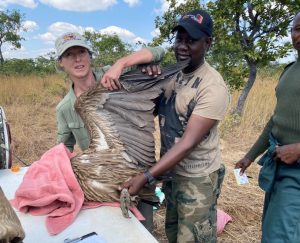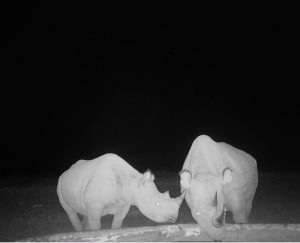Zoos play a vital role as sanctuaries and research hubs, dedicated to protecting endangered species, restoring habitats, and inspiring the next generation of conservationists, though often the public are unaware of their broader contributions to conservation. Did you know that global zoo populations contribute to the survival of over 1,000 endangered species through captive breeding and reintroduction programs?
Through our small grants programme, the Mohamed bin Zayed Species Conservation Fund has partnered with various zoos over the years, collaborating as invaluable allies in the recovery of threatened species. These institutions play a crucial role in the care, research, and genetic management of zoo-managed populations, facilitating essential captive breeding and reintroduction programs.
On Zoo Lovers’ Day, we want to shine a light on the remarkable conservation successes achieved by zoos that often go unnoticed. With more than 30 years of conservation experience, Dr. Allison Alberts, an Advisory Board member of the MBZ Fund, understands the impact zoos can have. Starting her career at the San Diego Zoo Wildlife Alliance in 1990, she believes that zoos and rescue centers possess the expertise in animal care, veterinary medicine, behaviour, and genetics necessary to rehabilitate animals and species and successfully reintegrate them into their native habitats. At the same time, animals in their care can serve as educational ambassadors and provide important opportunities for training and capacity enhancement in local communities.
 One inspiring example is the Allwetterzoo Münster, a dedicated conservation leader for nearly 25 years. This zoo has been instrumental in initiatives like the Angkor Centre for Conservation of Biodiversity (ACCB) in Cambodia, with a key focus on the critically endangered Bengal Florican (Houbaropsis bengalensis blandini). This species faces severe threats from habitat loss and environmental change, and the ACCB’s project, supported by the MBZ Fund, plays a crucial role in securing its survival. This collaborative effort exemplifies how ex-situ conservation can effectively preserve threatened species, contributing to the implementation of the One-Plan approach to Bengal Florican conservation.
One inspiring example is the Allwetterzoo Münster, a dedicated conservation leader for nearly 25 years. This zoo has been instrumental in initiatives like the Angkor Centre for Conservation of Biodiversity (ACCB) in Cambodia, with a key focus on the critically endangered Bengal Florican (Houbaropsis bengalensis blandini). This species faces severe threats from habitat loss and environmental change, and the ACCB’s project, supported by the MBZ Fund, plays a crucial role in securing its survival. This collaborative effort exemplifies how ex-situ conservation can effectively preserve threatened species, contributing to the implementation of the One-Plan approach to Bengal Florican conservation.
Philipp Wagner, Curator of Conservation & Research at Allwetterzoo, states, “Through partnerships like these, we can offer hope to species on the brink of extinction, ensuring that conservation efforts are not only effective but sustainable.”
 Similarly, the North Carolina Zoo has focused its efforts on conserving African vultures since 2014. With over 150 vultures tagged across southeastern Africa, the zoo and its partners have successfully identified and mitigated significant threats, such as pesticide poisoning at carcasses. Vultures are often victims of these incidents due to the illegal trade in their body parts and retaliatory killings aimed at predators like lions. Support from the MBZ Fund has enabled the zoo to expand its conservation efforts into Zambia, further enhancing its impact.
Similarly, the North Carolina Zoo has focused its efforts on conserving African vultures since 2014. With over 150 vultures tagged across southeastern Africa, the zoo and its partners have successfully identified and mitigated significant threats, such as pesticide poisoning at carcasses. Vultures are often victims of these incidents due to the illegal trade in their body parts and retaliatory killings aimed at predators like lions. Support from the MBZ Fund has enabled the zoo to expand its conservation efforts into Zambia, further enhancing its impact.
“With support from MBZ Fund, we have been able to expand methods developed in Tanzania to Zambia, enabling enhanced African vulture conservation,” added Corinne Kendall, Curator of Conservation and Research, North Carolina Zoo.
In the heart of Tsavo West, Kenya’s second-largest protected area, lies the Ngulia Rhino Sanctuary, home to the critically endangered black rhino (Diceros bicornis michaeli). This is where the Zoological Society of London (ZSL) aims to ensure the survival of this species, which is constantly threatened by poaching and the impacts of climate change. The Tsavo ecosystem is fragile, with unpredictable rainfall patterns and prolonged dry spells. To ensure year-round water availability for the growing black rhino population, an urgent repair of a 70,000-litre water reservoir was needed.
 Recognising this urgent need, ZSL collaborated with the Tsavo Trust and the Kenya Wildlife Service to secure a grant from the MBZ Fund. Their project, “Securing Water Resources for a Vital Population of the Critically Endangered Black Rhino in Tsavo, Kenya,” not only addressed water availability but also enhanced biological monitoring and strengthened rhino protection through daily adaptive security patrols supported by camera traps and GPS handsets. Since the project’s implementation, the black rhino population has stabilised, with five new births recorded and zero mortalities during the project phase (April – June 2024). While this success cannot be solely attributed to the grant, given the continued conservation efforts and other ongoing projects, the repaired water tank has played a critical role in supporting the species and the wider ecosystem.
Recognising this urgent need, ZSL collaborated with the Tsavo Trust and the Kenya Wildlife Service to secure a grant from the MBZ Fund. Their project, “Securing Water Resources for a Vital Population of the Critically Endangered Black Rhino in Tsavo, Kenya,” not only addressed water availability but also enhanced biological monitoring and strengthened rhino protection through daily adaptive security patrols supported by camera traps and GPS handsets. Since the project’s implementation, the black rhino population has stabilised, with five new births recorded and zero mortalities during the project phase (April – June 2024). While this success cannot be solely attributed to the grant, given the continued conservation efforts and other ongoing projects, the repaired water tank has played a critical role in supporting the species and the wider ecosystem.
Laura Jowell from ZSL reflects, ” With special gratitude to MBZ Species Conservation Fund and thanks to the hard work of everyone involved, we’ve managed to set a great recovery foundation in our sanctuary. The black rhinos are in a better place now, and so is the entire ecosystem, and it’s all for the love of our wildlife.”
These examples highlight how collaboration with zoos leads to positive outcomes not just for specific species, but for the wider ecosystems. From the Fund’s perspective, zoos play an essential role in successful conservation. With dedicated teams of experts and access to specialised equipment and facilities often unavailable to smaller conservation agencies, they are uniquely positioned to make a significant impact. Their commitment to wildlife conservation deserves recognition.
So, the next time you visit a zoo, take a moment to see the animals through a different lens. Take a moment to appreciate the vital role these institutions play in creating hope for species on the brink of extinction. Together, we can support their efforts and contribute to a brighter future for wildlife and the ecosystems they inhabit.

